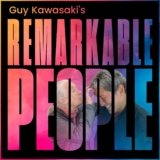In this episode of Remarkable People, join host Guy Kawasaki as he embarks on an awe-inspiring journey into the world of big wave surfing with the legendary ...
Join host Guy Kawasaki on Remarkable People as he engages in a thought-provoking conversation with Amy Edmondson, an esteemed Professor of Leadership and ...
Step into the inspiring world of Jonathan Conyers’ journey on Guy Kawasaki’s Remarkable People podcast. From humble beginnings to extraordinary ...
In this special birthday episode of Remarkable People, join host Guy Kawasaki as he reflects on his remarkable career and shares insights from his young life. ...
Join Guy Kawasaki in this episode of Remarkable People as he engages in a thought-provoking conversation with Mauro Guillén, the Dean of the University of ...
In this episode of Remarkable People, join host Guy Kawasaki as he engages in a thought-provoking conversation with one of his idols, Carol Dweck. Carol, a ...
In this episode of Remarkable People, join host Guy Kawasaki as he engages in a groundbreaking conversation with Doris Taylor, a visionary scientist at the ...
Fashion advocate Alden Wicker uncovers the critical issues plaguing the fashion industry, offering actionable steps to effect positive change. The discussion ...
Don Norman emphasizes the importance of humanity-centered design, which considers the impact of design on the environment, society, and all living things. He ...
Join Guy Kawasaki in a transformative conversation with Dr. Gladys McGarey, the Mother of Holistic Medicine. Tune into Remarkable People for insights into ...
Explore the world of cognitive psychology with Daniel Simons in the latest episode of the Remarkable People podcast. Enhance your decision-making skills and ...
Ever wondered what it’s like to dive into the depths of the ocean and come face-to-face with one of nature’s most majestic creatures? Join me on a ...
This week on Remarkable People, we’re exploring the world of Stacey Abrams, a relentless advocate for democracy. Dive into her inspiring story of ...
Explore the art of argumentation and persuasion with Mehdi Hasan in the latest episode of the Remarkable People podcast. Tune in for an enlightening ...
Join Gretchen Rubin, author of The Happiness Project, as she reveals the secrets to optimizing your senses and unlocking your true potential. 🌟 Listen now to ...
Ever wondered how a remarkable employee experience can transform your business? Join us in our latest episode of the Remarkable People podcast as we delve into ...
In this candid conversation, high school English teacher Kelly Gibson shares her experiences and insights on dealing with everyday challenges and pressures in ...
Discover the fascinating world of incentives and their impact on human behavior, innovation, and ethical considerations with Uri Gneezy and Guy Kawasaki on the ...
Are you struggling to find a balance between your work and personal life? Tune in to the Remarkable People podcast with Tina Wells, a renowned business ...
Are you looking for innovative strategies for achieving growth without displacement? Look no further than our latest podcast episode featuring Renée Mauborgne, ...
- « Previous Page
- 1
- …
- 5
- 6
- 7
- 8
- 9
- …
- 17
- Next Page »

